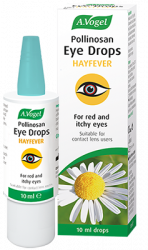What is a pollen count?
Hayfever occurs when the immune system overreacts to contact with pollen. This causes it to release histamine thus bringing on symptoms like a blocked nose and itchy eyes. It is therefore unsurprising that a high pollen count can contribute to severe hayfever symptoms but how exactly is the pollen count calculated in the first place?
Well, the pollen count is determined by the number of pollen grains in a cubic meter of air. There is an individual pollen count for grass, weeds such as nettle and also trees including elm, ash and alder. A count of 50 pollen grains or less is considered low whilst anything above 1000 is deemed high. As the number of plants differs from place to place, the levels of pollen differ too but there are some other factors that contribute to high pollen counts as well.
1 Season
Plants pollinate at different times of the year and so this explains why pollen counts rise and fall depending on the season. Grass pollinates between the middle of May and July for example, and so this is when counts are highest and symptoms are likely to be severe. Weeds on the other hand, pollinate a little later between the months of June and October. For trees however, pollination spans over March and May.
Although it is not uncommon for hayfever symptoms to develop out with these summer months, pollen counts are definitely highest and symptoms are most likely to develop at this time.

2 Weather
As I discussed in my blog ‘What effect does the weather have on hayfever sufferers?’, the weather definitely contributes to high pollen counts.
The reason for this is simple - plants release their pollen when the weather is sunny and so this is when counts are likely to soar. If the weather is cloudy though, plants do not release their pollen and instead it builds up. This means that when the sunny weather returns again, lots of pollen is released into the air thus raising the overall pollen count.1
3 Temperature
When sunny weather is accompanied by warm temperatures this can cause pollen counts to rise even further. That’s because humidity causes individual pollen grains to swell and then burst into lots of small pollen particles. Not only does this mean there are more pollen particles in the air, as the pollen is also smaller it is easily breathed in through the nose and mouth thus exasperating hayfever symptoms here. That’s not all though, heat causes pollen to rise meaning that, once again, it reaches the nose, throat and eyes thus bringing on the likes of sneezing, watery eyes and a sore throat.
4 Time of day
Pollen counts tend to be highest in the middle of the day because, as I mentioned, heat causes pollen to rise. When the temperature cools again pollen falls back to ground level and counts begin to drop. However, this isn’t the only reason for high pollen counts in the middle of the day. Birch trees release their pollen in the afternoon for example, meaning counts are highest at this time and your symptoms are likely to develop.

Where can I find my local pollen count?
It is important to keep track of the pollen count so that you can plan ahead in terms of the activities you do and the hayfever remedies you take. Here at A.Vogel we recognized this and so set up a 5 day pollen forecast for over 30,000 locations in the UK! Here you’ll find information on tree, weed and grass pollen to help you stay on top of your hayfever symptoms regardless of the trigger.

Helpful remedies for hayfever sufferers!
I regularly recommended our Pollinosan Hayfever Tablets for those suffering from the condition because this offers a natural and effective solution to symptoms such as watery eyes, sneezing and a tickly throat. However, there are other options you could try as well that are suited to specific problems such as a blocked nose. Here our Pollinosan Nasal Spray would prove most helpful as this cleanses the nose of allergens thus working to soothe and comfort the area.





 Looking for relief of red and itchy eyes due to hayfever?
Looking for relief of red and itchy eyes due to hayfever?

